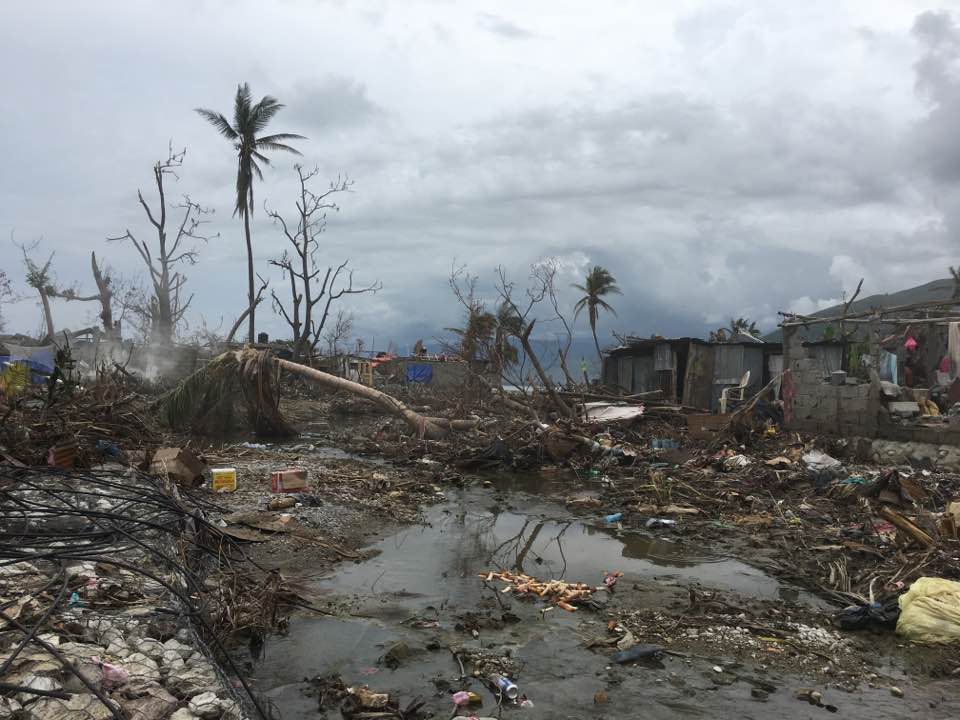You are here

Photo by John Carroll
blogs.pjstar.com - by John Carroll, MD - November 2, 2016
October 27, 2016
“The surest way to be caught flatfooted by disasters is to not know or understand, or else ignore, the value of the land and people who should have been protected, commensurate with the degree to which others depend on what they produce. This is the case with Haiti’s disregard for the values of the Greater South Region which is basically all that lies below and west of the crossroads of Leogane.”
Stuart Leiderman
————
We left Cayes early this morning and headed south and west. And the further we traveled, Matthew’s wrath and destruction was even more horrific. Coconut and palm trees were snapped or uprooted everywhere. Houses were smashed. Roofs were missing. And debris littered the beach down the entire coast. Police stations, courthouses, and churches were destroyed everywhere.
The villages we passed through (or by) after leaving Cayes were Chantal, Torbeck, Port Salut, Roch-a-Bateau, Coteaux, Damassin, Port-a-Piment , Kalapa, and Chardonnieres. After leaving Chardonnieres we traveled west for another 30 minutes but were unable to cross the wide and deep Les Anglais River and so we had to turn back. (Most of the road from Port Salut heading west was gravel or sand.)
The people’s gardens and fields had been destroyed by Matthew. Their mangos, coconuts, avocados, breadfruit (veritab), and coffee crops were gone. And so was their livestock.
And everywhere we went people were working to stay alive that day. Fallen trees and branches were being cut with machetes held by strong arms. Cinderblocks were being stacked from fallen houses. And blue tarps and shiny silver corrugated metal were used for patching or repairing roofs.
———
Port Salut
We stopped at the MSPP hospital here. This hospital was right on the beach and must have taken a tremendous pounding from Matthew, but it stood up well due to the fact that it is made of good concrete. On the south side of the hospital, the beach was torn up something terrible with debris at the hospital’s back door.
There were two Cuban doctors working inside. Dr. Yurisley appeared to be about 30 years old and had a very happy and welcoming smile. She said she had been working in the Port Salut hospital for 17 months. When I asked her if they had enough Ringer’s Lactate to treat cholera she replied that they were well supplied. When I asked where the Ringer’s came from she said Cuba.
Their Cholera Treatment Center (CTC) had just three cholera patients—a little boy and girl and an elderly female. A man mopping the CTC floor was the little boy’s dad. The man said that all three of them had come from two zones west of Port Salut called Rosier and Bolieu. And he said there was more cholera out there now due to the recent rains and that people were dying of cholera in these areas because they could not get to the CTC due to the flooding. The CTC nurse told me that they had treated 30 cholera patients during the last couple of weeks.
————
Damassin
Straight northwest of Port Salut was another destroyed village called Damassin. People were sitting in front of their broken homes. They told me that they had no food and water prices were being raised. Three tiny plastic bags of clean water were costing 10 gourdes (about 15 cents US), which most people don’t have.
(CLICK HERE - READ COMPLETE ARTICLE)



Recent Comments